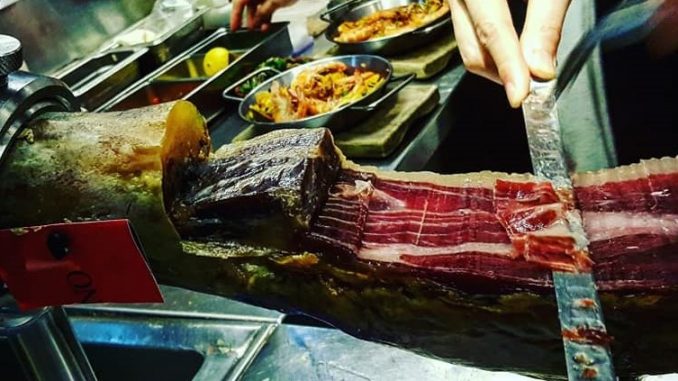
Ham & Sherry
“Just to eat is a gift.”
Ferran Adria
A small, hole-in-the-wall ‘Bodega’ down a little lane in Wan Chai -noticeable by the Catalan style blue and white wall tiles on its exterior- is home to Hong Kong’s largest selection of aged hams and its most impressive list of Sherries.
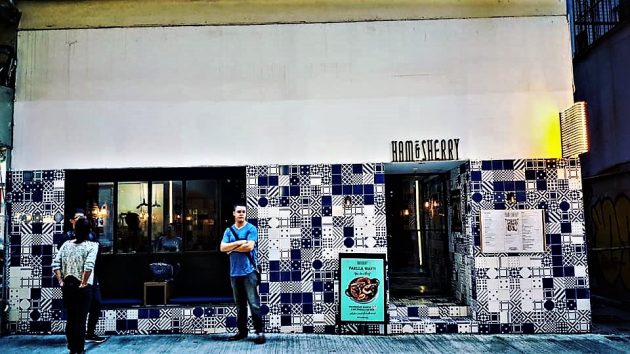
Ham & Sherry is the brain child of Jason Atherton and Yenn Wong, the dynamic duo behind the ever popular 22 Ships eatery in the very same small lane in Wan Chai. A modern, cantina style interior, set around a stainless steel, u-shape bar come plating station; the architecture and interior design, (by Shanghai’s Neri & Hu) pays homage to the tradition and culture of its Spanish roots. Dishes are a mix of tapa, para picar, Spanish signatures and playful takes on Iberian classics.
Always busy and bustling with energy, the space has a great atmosphere, the kitchen runs with impressive precision; plating up dishes before your eyes and offering simply delicious food that is all about consistency, perfect execution and high quality ingredients.
The service staff are good fun too, efficient, friendly, helpful, they are confident professionals who seem relaxed and happy to share their favourite dishes, sherries and pairings; making recommendations when requested.
I prefer to sit up at the bar where the action is, you can see legs of Iberico ham being expertly carved, small dishes being plated up and the rattle and hum of a great restaurant enjoying the flow of yet another good night.
The menu is made up of mostly small plates and small boards, ideal for mixing and matching with friends. Hocks of cured ham hang in glass cabinets that descend from the ceiling, there are sherries of the month and special dishes on blackboards, whilst signature dishes are pointed out on the tight but well-varied menu.
The sherries are outstanding, sublime with the Iberico ham and most of the cuisine on offer, there are sweet, dry, cream, nectar, young and aged options and if not familiar, this is the perfect place to acquaint yourself with the treasures of Jerez de la Frontera, Andalusia’s gift to the world. There is also a tight, well-considered selection of Spanish, Portuguese and Italian wines that pair very well.
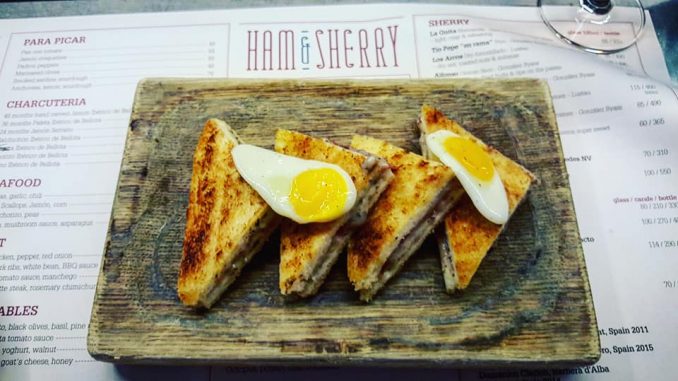
Tapas
A tapa is an appetizer in Spanish cuisine and translates to a small portion of almost any type of Spanish food, it may be a dish served hot or cold. Traditionally, this was presented on a piece of bread, ham or even a small plate set atop your glass and was usually only served in bodegas, cantinas, posadas and albergues across Spain. Today, there are bars and restaurants right across the globe that have evolved tapas into a cuisine that can be combined to make a full meal.
The word Tapas is derived from the Spanish verb ‘tapar’ which means to cover. There are several legends as to how it was invented and became popular.
A well-known tale can be traced back to the thirteenth century and the Castilian King, Alfonso X, who, whilst suffering from illness, could only take his wine and food in small portions. Upon his recovery the king ordered that no wine should be served in taverns without a little food -so as the peasants could not drink on an empty stomach.
A more probable legend, (given the name) has it that to stop dust, fruit flies and other insects or impurities from entering their clientele’s beverages, (usually a sweet sherry) inn-keepers in and around Andalusia would place a slice of bread, ham or Chorizo over the top of the drinking vessel.
In an era when few could read, competing owners soon realized that these small ‘lids’ could act as a sort of billboard or shop window for the food they served -as well as an extra incentive for potential customers to choose their establishment over another. Eventually, the tapa became more, layered, elaborate and adorned with all manner of ingredients in order to attract the goodwill of their patrons.
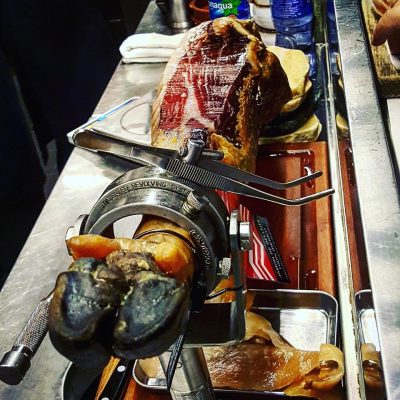
Ham
Iberian Ham (Jamon Iberico pata negra) is the name of the breed of pigs on the Iberian Peninsula, so named for their black hooves, (pata negra means black paw). The ham from this breed has a texture, flavour and aroma that has made it famous throughout the world. The Iberian breed has a unique marbling content and texture of fat that plays an important role in its quality and characteristics.
In Spain, the black Iberian pig is found in the provinces of Huelva (protected denomination of origin Huelva), Córdoba (protected denomination of origin Valle de Los Pedroches), Cáceres, Badajoz (protected denomination of origin Dehesa de Extremadura), Salamanca, Ciudad Real, and Seville. In Portugal the central and southern regions have an abundance of this species, with a predilection for the Alentejo region. The ibérico hams from the towns of Guijuelo in the Salamanca province and Jabugo in the Huelva province have their own denominación de origen. Almost the entire town of Jabugo is devoted to the production of jamón ibérico; the biggest producer is 5J Sánchez Romero Carvajal. The town’s main square is called La plaza del Jamón.
The official classification of Iberian hams follows two criteria according to the new certification of 2014, based on the breed of the pig and are as follows. Iberian 50%: Iberian hams that are from a 50% Iberian pig breed, this means that only one of the parents, usually the female, is 100% Iberian breed. Iberian 100%: This is the famous “pata negra” and the ham comes from 100% Iberian breed pigs, which of course means that both parents must be 100% Iberian breed.
Immediately after weaning, the piglets are fattened on barley and maize for several weeks. The pigs are then allowed to roam in pasture and oak groves to feed naturally on grass, herbs, acorns, chestnuts, and roots, until the slaughtering time approaches. At that point, the diet may be strictly limited to olives, chestnuts or acorns for the best quality jamón ibérico, or may be a mix of acorns and commercial feed for lesser qualities.
After classification according to breed there are then three categories:
Jamón Ibérico de Bellota: This type of ham comes from pigs which have been fed with acorns until they reach 50 kilos weight. This is the highest quality ham. Depending on the percentage of Iberian breed, the color of its label is black (for those 100%) or red (for those 50%).
Cebo de Campo: This type of ham comes from pigs which has been feed with a combination of both pasture and feed lot. Those are raised in large open pastures so that the pig has room to roam around and this improves the quality of the ham. The color of its label is dark green, regardless of the purity breed’s pig.
Cebo: This type of hams comes from pigs that have exclusively been fed from feed lots. The colour of its label is white regardless of the purity of the Iberian breed.
The ‘dehesa’ or pastures of oak forests where the Iberian pigs are raised is traditionally in Extremadura, Spain where it has been observed by locals -as some acorns are sweeter than others- Iberian pigs will look for the sweeter acorns like children looking for candies. They can eat about 7 kg per day. To get the most out of the oak trees, there is the “vareado” (a person hitting the tree with a long stick) used to bring down the acorns so that the pigs can enjoy them freshly when fallen from the tree.
Cured meats have been specifically produced to be edible for a long time. The curing process was used for generations to preserve pork before the invention of refrigeration. During the curing process the meat is dried in salt, which helps to prevent the build-up of harmful organisms, and then is hung to be exposed to the elements, producing an exterior layer of mold which helps to protect the meat inside.
The production process is slow and laborious, it can take from 15 months up to 4 years and consists of several stages:
Inspection and classification
Salting and Brining
Resting
Dry Ageing
The Ham Master (Maestro Jamonero) plays an extremely important role in this process, he controls the time of each different stage, depending on the characteristics of each group of hams.
Once in the restaurant different parts of the ham provide different degrees of curation and different types of slices:
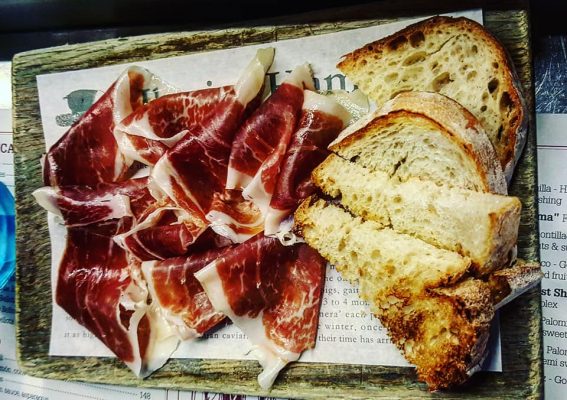
La Maza: The largest part of the ham and tastiest one. If you put the ham in the ‘jamóneros with the hoof upwards, then the large mound in front of you is “la maza”.
La Babilla o Contramaza: The part behind or on the other side to the “maza”. It is narrower and slightly dryer because it’s covered with less fat.
El Codillo: Is located between the “caña” and the “maza”. It is the more fibrous part of the whole piece.
La Punta: Totally opposed to the hoof. It is very tasty and has a good level of fat.
La Caña: The closest part to the hoof. Being also very fibrous is usually cut in small cubs for “tapas”. This cut provides different flavour and texture to the slices.
Ham and Sherry currently lists:
48 month aged hand carved Jamón Ibérico de Bellota,
36 month aged Paleta Ibérico de Bellota,
The ‘Ham’ is the beck leg whereas the ‘Paleta’ is the front leg and shoulder. There are specific differences between the Ham and the Paleta:
Specific features of the ham, the back leg:
Approximate weight: between 7 and 8.5 kg
The proportion of bone and fat is approximately 50% of the total weight.
Longer curing time than the ham shoulder: from 15 to 36 months.
Higher price.
Their anatomy allows easier cutting and bigger slices.
Specific features of the shoulder ham, the front leg:
Approximate weight between 4 and 5.5 kg
The proportion of bone and fat is approximately 60% of the total weight.
Shorter curing time: 12 to 24 months depending on the quality.
Cheaper than the ham for the same quality.
The anatomical shape of the bones makes its cutting a little more complicated than the back leg ham.
24 month aged Jamón Serrano
There are written references about the Serrano ham in Hispania, late 2nd century BC, by the Romans. They are also sometimes called white pigs because of their whiter, clearer coloured hoof.
Considered to have a slightly saltier flavour and a more fibrous texture with less intensity of flavour and aroma than the Iberico Ham.
The official classification of the Serrano ham depends on the dry curing and maturation. There are 3 types of Serrano ham:
Serrano Bodega: Curing time from 10 to 12 months.
Serrano Reserva: Curing time from 12 to 15 months.
Serrano Gran Reserva: More than 15 months of curing time.
Ham and Sherry also has an exquisite selection of Salchichón Ibérico de Bellota, Copita Ibérico de Bellota, Lomito Ibérico de Bellota and Chorizo Ibérico de Bellota.
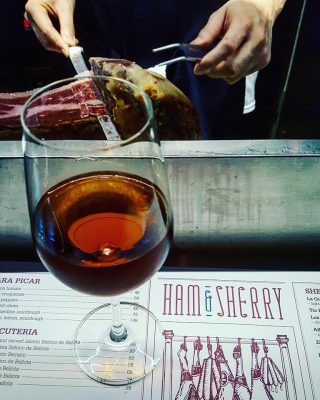
Sherry
“Wine is the intellectual part of the meal.”
Alexandre Dumas
Sherry is a fortified wine made from white grapes that are grown near the city of Jerez de la Frontera in Andalusia, Spain. Sherry is produced in many different styles ranging from light, crisp and dry to rich, creamy and very sweet. It is primarily made from the Palamino grape, (90% of all sherry produced) Pedro Ximinez, (for most of the sweeter styles) and Moscatel (occasionally), either on their own or blended (with Palamino).
Jerez has been a centre of viniculture since wine-making was introduced to Spain by the Phoenicians in 1100 BC. The practice was carried on by the Romans when they took control of Iberia around 200 BC. The Moors conquered the region in AD 711 and introduced distillation, which led to the development of brandy and fortified wine.
By the end of the 16th century, sherry had a reputation in Europe as the world’s finest wine.
Christopher Columbus brought sherry on his voyage to the New World and when Ferdinand Magellan prepared to sail around the world in 1519, he spent more on sherry than on weapons.
Sherry became very popular in Great Britain, especially after Francis Drake sacked Cadiz in 1587. Because sherry went on to become a major wine export to the United Kingdom, many English companies and styles developed. Many of the Jerez cellars were founded by British families.
The word “Sherry” is an anglicisation of Xeres (Jerez). Sherry was previously known as sack, from the Spanish saca, meaning “extraction” from the solera. Sherry has a protected designation of origin status, and under Spanish law, all wine labelled as “Sherry” must legally come from the Sherry Triangle, an area in the province of Cádiz between Jerez de la Frontera, Sanlúcar de Barrameda, and El Puerto de Santa María.
After fermentation is complete, the base wines are fortified with grape spirit in order to increase their final alcohol content. Wines classified as suitable for aging as Fino and Manzanilla are fortified until they reach a total alcohol content of 15.5 per cent by volume. As these wines age in barrel, they develop a layer of unique, indigenous yeast known flor, which helps to protect the wine from excessive oxidation.
Most sherries are produced using a solera system where older barrels are used to top up younger barrels in a continuous system designed to preserve a consistent quality of aged character and flavour in the wines.
Because the fortification takes place after fermentation, most sherries are initially dry, with any sweetness being added later. In contrast, port wine is fortified halfway through its fermentation, which stops the process so that not all of the sugar is turned into alcohol.
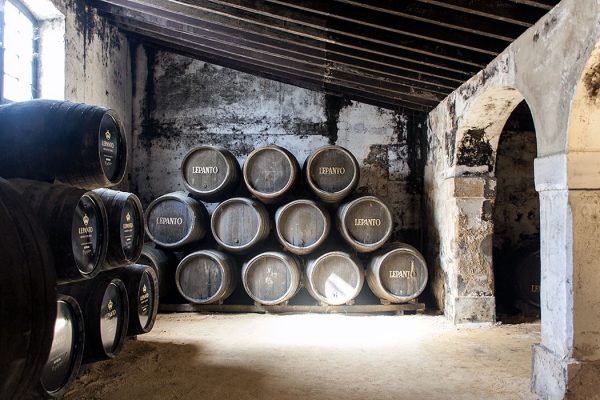
Types of Sherry
Fino (‘fine’ in Spanish) is the driest and palest of the traditional varieties of Sherry. The wine is aged in barrels under a cap of flor yeast to prevent contact with the air. The very best come for the chalky ‘albariza’ soils. The benefit of the albariza soil is that it can reflect sunlight back up to the vine, aiding it in photosynthesis. The nature of the soil is very absorbent and compact so that it can retain and maximize the use of the little rainfall that the Jerez region receives.
Manzanilla is an especially light variety of Fino Sherry made around the port of Sanlúcar de Barrameda.
Manzanilla Pasada is a Manzanilla that has undergone extended aging or has been partially oxidized, giving a richer, nuttier flavour.
Amontillado is a variety of Sherry that is first aged under flor and then exposed to oxygen, producing a sherry that is darker than a Fino but lighter than an Oloroso.
Oloroso (‘scented’ in Spanish) is a variety of sherry aged oxidatively for a longer time than a Fino or Amontillado, producing a darker and richer wine. With alcohol levels between 18 and 20%, Olorosos are the most alcoholic sherries. Like Amontillado, naturally dry, they are often also sold in sweetened versions called Cream sherry (first made in the 1860s by blending different sherries, usually including Oloroso and Pedro Ximénez).
Palo Cortado is a variety of Sherry that is initially aged like an Amontillado, typically for three or four years, but which subsequently develops a character closer to an Oloroso. This either happens by accident when the flor dies, or commonly the flor is killed by fortification or filtration.
Jerez Dulce (Sweet Sherries) are made either by fermenting dried Pedro Ximénez (PX) or Moscatel grapes, which produces an intensely sweet dark brown or black wine, or by blending sweeter wines or grape must with a drier variety.
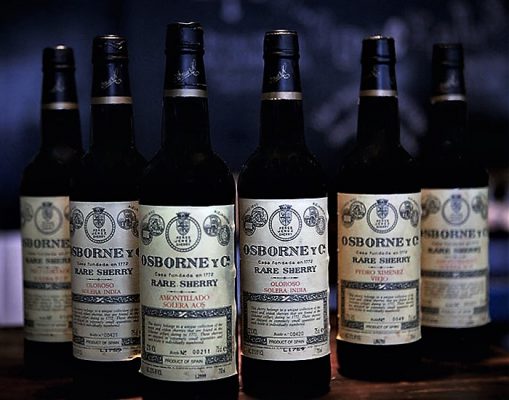
The classification by sweetness is:
Fortified Wine Type Alcohol % ABV Sugar content (grams per litre)
Fino 15–17 0–5
Manzanilla 15–17 0–5
Amontillado 16–17 0–5
Palo Cortado 17–22 0–5
Oloroso 17–22 0–5
Dry 15–22 5–45
Cream 15.5–22 115–140
Dulce / Sweet 15–22 160+
Moscatel 15–22 160+
Pedro Ximénez 15–22 212+
The Palomino grapes are harvested and very lightly pressed. The first pressing or primera yema, is used to produce Fino and Manzanilla; the must from the second pressing will be used for Oloroso.
The must is then fermented in stainless steel vats producing a dry white wine with 11–12 per cent alcohol. Immediately after fermentation the wine is sampled and the first classification is performed. The casks are marked with the following symbols according to the potential of the wine:
/ a single stroke indicates a wine with the finest flavour and aroma, suitable for Fino or Amontillado. These wines are fortified to about 15 per cent alcohol to allow the growth of flor.
/. a single stroke with a dot indicates a heavier, more full-bodied wine. These wines are fortified to about 17.5 per cent alcohol to prevent the growth of flor, and the wines are aged oxidatively to produce Oloroso.
// a double stroke indicates a wine which will be allowed to develop further before determining whether to use the wine for Amontillado or Oloroso. These wines are fortified to about 15 per cent alcohol.
/// a triple stroke indicates a wine that has developed poorly, and will be distilled.

The sherry is fortified using destilado, made by distilling wine, usually from La Mancha. The distilled spirit is first mixed with mature sherry to make a 50/50 blend known as mitad y mitad (half and half), and then the mitad y mitad is mixed with the younger sherry to the proper proportions. This two-stage procedure is performed so the strong alcohol will not shock the young sherry and spoil it.
The fortified wine is stored in 500-litre casks made of North American oak, which is more porous than French or Spanish oak. The casks, or butts, are filled five-sixths full, leaving “the space of two fists” empty at the top to allow flor to develop on top of the wine.
Sherry is then aged in the solera system where new wine is put into wine barrels at the beginning of a series of three to nine barrels. Periodically, a portion of the wine in a barrel is moved into the next barrel down, using tools called the canoa (canoe) and rociador (sprinkler) to move the wine gently and avoid damaging the layer of flor in each barrel. At the end of the series only a portion of the final barrel is bottled and sold. Depending on the type of wine, the portion moved may be between five and thirty percent of each barrel. This process is called “running the scales” because each barrel in the series is called a scale. Thus, the age of the youngest wine going in the bottle is determined by the number of barrels in the series, and every bottle also contains some much older wine than is stated. Sherry is aged in the solera for a minimum of two years. A large solera system may consist of scales that require more than one barrel to hold. The word ‘solera’ means ‘on the ground’; this refers to the stacking system that was, and sometimes still is, used, with the youngest barrels at the top and the oldest scale, at the bottom.
Of late, Sherry producers and marketers have been bottling their wines en rama, with only a light filtration, and often a selection of a favored barrel from a larger solera. Such sherries can be considerably more complex in flavour than the standard bottlings and are worth seeking out.
In order to allow the sale of reliable average age-dated sherries, the regulating council has set up a system that accurately tracks the average age of the wines as they move through their solera. Two average age-dated categories are recognized: VOS (‘Vinum Optimum Signatum’ – 20 years old average age minimum) and VORS (‘Vinum Optimum Rare Signatum’ – 30 years old average age minimum).
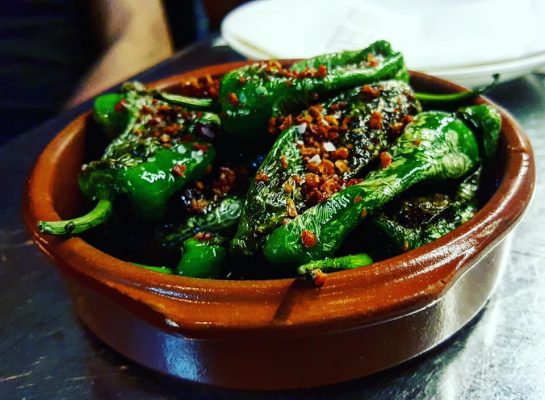
Plates
The Ham Cheese Toastie is a beguiling signature; few can stop at just one, Iberico ham, Manchego cheese, truffle oil, thick-cut, de-crusted bread all topped with a couple of quail eggs; this elevates a humble diner snack to something devilishly good and outrageously delicious.
The Pork Ribs with white beans and bbq sauce are fall-of-the-bone, tender, juicy perfection.
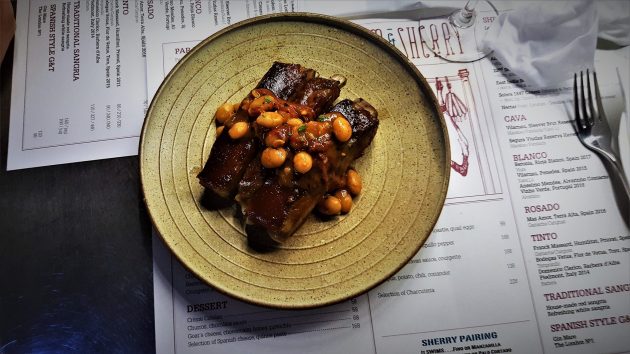
The Braised Lamb is tender and richly flavoured, served with an exceptional bravas sauce made with smoked paprika and courgette.
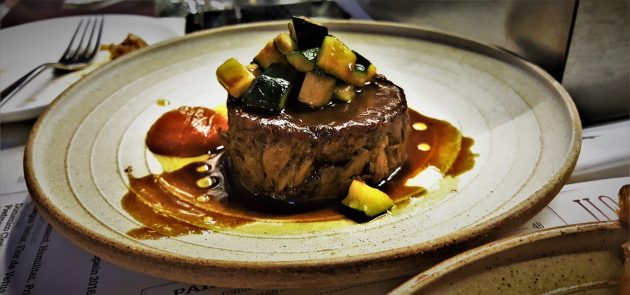
Seafood paella, an incredible paella, rich and layered yet light and fresh, served with chilies and fruity, sweet piquillo peppers.
Courgette Flower, this is an exquisite dish, the zucchini flower is done in the lightest of fine, crisp ‘tempura style’ batter and served with goats cheese and honey for a truly amazing flavour and texture experience.
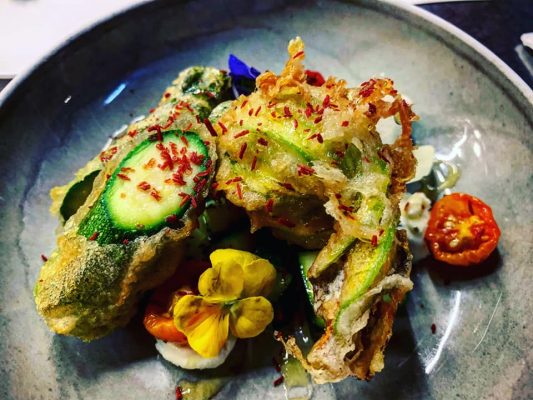
Padron Peppers, A Galician classic, these Pimientos de Padrón are blister fried, drizzled with olive oil and sprinkled with friend garlic, these fresh, crisp peppers are a perfect starter with a crisp, dry fino sherry.
Goat’s Cheese Cheesecake, Sweetness, richness and goodness here with honey and pistachio.
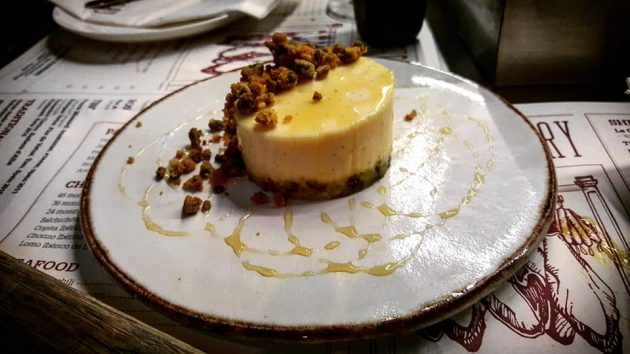
Churros, the traditional Iberian dessert or snack, a choux pastry style sugary doughnut dipped in a hot chocolate sauce. The dish is thought to have found its way to Spain via Portugal, who in turn brought an early version of the dish back from expeditions into China, in Hong Kong, this is the classic way to finish your meal at Ham and Sherry.
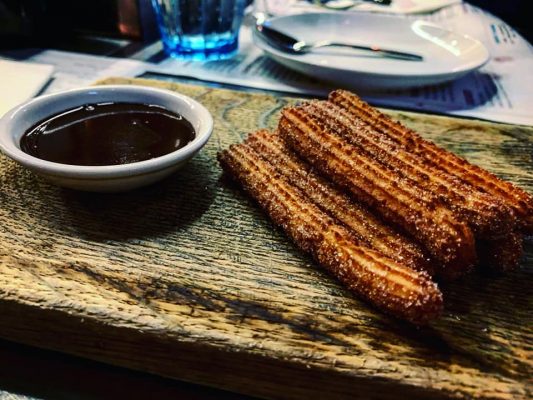
A playful little guide at the bottom of the menu offers to assist with food and sherry pairings;
If it SWIMS: Fino or Manzanilla,
if it FLIES: Amontillado or Palo CortadoIt,
if it RUNS: Oloroso
Jason Atherton
English chef and restaurateur Jason Atherton has worked with chefs including Pierre Koffmann, Nico Ladenis, and Marco Pierre White. He joined the Gordon Ramsay Group in 2001 as the executive chef for Verre in Dubai. In 2005, Jason returned to the UK and opened Maze before going on to open a series of restaurants for Ramsay in Cape Town South Africa, Melbourne Australia and Qatar.
Fay Maschler is the restaurant critic of London’s Evening Standard newspaper, having won a contest for the position in 1972. This was supposed to last for three months but she has remained in the position evern since and has now been there for over 40 years. Some ten years ago she said;
“Should you hold a knife to my throat and force me to say which one of the chefs in the Gordon Ramsay group I thought was the best, my answer would be Jason Atherton. Actually, I’d admit it without any coercion.”
Atherton left Gordon Ramsay Holdings in 2010 to launch his own restaurant company, he launched his first restaurant, Table No. 1, at the Waterhouse at South Bund hotel in Shanghai in May 2010 it been awarded one Michelin star, Pollen Street Social, opened in April 2011 in Mayfair and was awarded a Michelin star within its first six months. The restaurant has been ranked as high as number three in The Good Food Guide’s Top 50 Restaurants was deemed London’s best new fine dining restaurant in the Time Out Eating & Drinking Awards 2011. Pollen Street also won New Restaurant of the Year at the Craft Guild of Chefs Awards 2012. In 2014 the restaurant won Food and Travel Magazine Readers Award’s “Restaurant of the Year – UK”.
In 2013, Atherton opened two different ventures in London. The first was Little Social, a French brasserie-style restaurant located opposite his flagship restaurant. A short while later he opened the more casual modern British restaurant, Social Eating House, on Soho’s Poland Street, as well as his second venue in Shanghai, The Commune Social and in the autumn of 2013, Atherton launched Berners Tavern within the London EDITION hotel.
2014 saw the openings of 2 new members in the “Social” restaurant family with City Social in Tower 42, London, which won a Michelin star within six months of opening, and Aberdeen Street Social in Hong Kong. In 2015, Atherton opened The Clocktower within the New York EDITION hotel. This was followed by Social Wine & Tapas in London’s Marylebone. In September, Jason opened his first ‘Social’ restaurant in Dubai, Marina Social, within the new Intercontinental Dubai Marina.
In June 2016, Atherton opened his first restaurant in Cebu, Philippines – The Pig and Palm, this restaurant serves as his love letter to his beloved wife, Ihra who is herself from the Philippines.
Atherton’s recipes and articles have appeared widely in magazines and newspapers including: Jason Atherton has written half a dozen books on his cuisine and as well as being a television guest on Saturday Kitchen and Great British Menu, he also hosted the show My Kitchen Rules with Lorraine Pascale in 2014. In 2016 Jason was a guest judge for an episode of MasterChef Australia.
Yenn Wong
Yenn Wong is a Singaporean restaurateur who is the CEO and founder of the Hong Kong-based JIA Group which runs several restaurants across Hong Kong. In collaboration with British chief Jason Atherton she runs the two star Michelin restaurant Duddell’s, as well a number of bars and eateries serving international cuisines. In 2014 she was named Restaurateur of the Year for her contributions to the Hong Kong dining scene.
Wong was born in Singapore in 1978 and at the age of 25 was sent to Hong Kong to help develop a building in Causeway Bay recently acquired by her father, Malaysian business tycoon Danny Wong. After turning it into a boutique hotel named J Plus Hotel she traveled to Shanghai where she opened another hotel before opening multiple restaurants across Asia. Today she has consolidated her businesses into the running of nine restaurants in Hong Kong, each of which varying in style of cuisine. In 2016 she announced the opening of her tenth restaurant Commissary in Hong Kong and in 2017 a branch of Dundell’s was opened in London.
Ham & Sherry
Ham & Sherry originally opened to take on some of the overflow from the pair’s 22 Ships restaurant collaboration just a little further up Ship Street but; the overall theme, look, feel and sheer quality here just knocks it out of the park for simple, stunning Spanish dishes, divine hams and sensational sherries.


